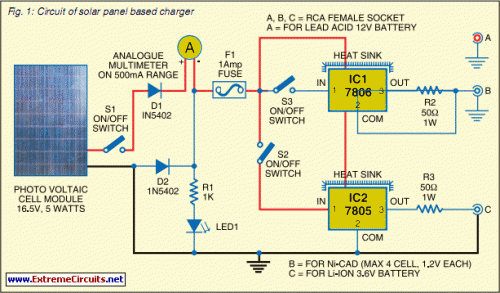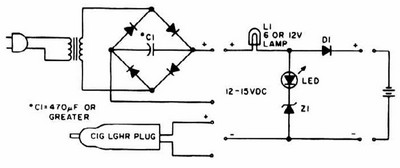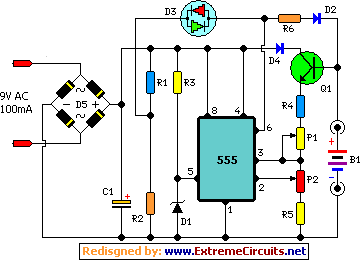
Solar Panel Based Charger And Small LED Lamp

Switching to alternative power sources can lead to savings on electricity bills. The photovoltaic module or solar panel discussed here has a power output of 5 watts. Under full sunlight conditions, the solar panel generates 16.5V and can provide a current ranging from 300 to 350 mA.
The photovoltaic module is designed to convert sunlight into electrical energy through the photovoltaic effect. It consists of numerous solar cells made primarily from semiconductor materials, such as silicon. When sunlight strikes the solar cells, it excites electrons, creating an electric current.
This particular solar panel is rated at 5 watts, which indicates its maximum power output under optimal conditions. The voltage output of 16.5V signifies that the panel can be used effectively in various applications, including powering small electronic devices, charging batteries, or feeding into a larger solar power system. The current output of 300 to 350 mA is adequate for low-power devices and can be utilized in off-grid applications where conventional power sources are unavailable.
When integrating this solar panel into a system, it is essential to include a charge controller to manage the energy flow, particularly if the output is used for charging batteries. The charge controller prevents overcharging and ensures the longevity of the battery system. Additionally, the panel should be mounted at an angle that maximizes sunlight exposure throughout the day, typically oriented towards the sun's path.
In applications where multiple panels are used, they can be connected in series or parallel configurations to achieve desired voltage and current levels. Series connections increase the voltage output while maintaining the same current, whereas parallel connections maintain the voltage but increase the current capacity.
Overall, this photovoltaic module serves as a viable solution for reducing electricity costs while promoting the use of renewable energy sources. Its specifications make it suitable for various applications, contributing to a sustainable energy future.You can save on your electricity bills by switching to alternative sources of power. The photovoltaic module or solar panel described here is capable of delivering a power of 5 watts. At full sunlight, the solar panel outputs 16.5V. It can deliver a current of 300-350 mA. Using it . 🔗 External reference
The photovoltaic module is designed to convert sunlight into electrical energy through the photovoltaic effect. It consists of numerous solar cells made primarily from semiconductor materials, such as silicon. When sunlight strikes the solar cells, it excites electrons, creating an electric current.
This particular solar panel is rated at 5 watts, which indicates its maximum power output under optimal conditions. The voltage output of 16.5V signifies that the panel can be used effectively in various applications, including powering small electronic devices, charging batteries, or feeding into a larger solar power system. The current output of 300 to 350 mA is adequate for low-power devices and can be utilized in off-grid applications where conventional power sources are unavailable.
When integrating this solar panel into a system, it is essential to include a charge controller to manage the energy flow, particularly if the output is used for charging batteries. The charge controller prevents overcharging and ensures the longevity of the battery system. Additionally, the panel should be mounted at an angle that maximizes sunlight exposure throughout the day, typically oriented towards the sun's path.
In applications where multiple panels are used, they can be connected in series or parallel configurations to achieve desired voltage and current levels. Series connections increase the voltage output while maintaining the same current, whereas parallel connections maintain the voltage but increase the current capacity.
Overall, this photovoltaic module serves as a viable solution for reducing electricity costs while promoting the use of renewable energy sources. Its specifications make it suitable for various applications, contributing to a sustainable energy future.You can save on your electricity bills by switching to alternative sources of power. The photovoltaic module or solar panel described here is capable of delivering a power of 5 watts. At full sunlight, the solar panel outputs 16.5V. It can deliver a current of 300-350 mA. Using it . 🔗 External reference





